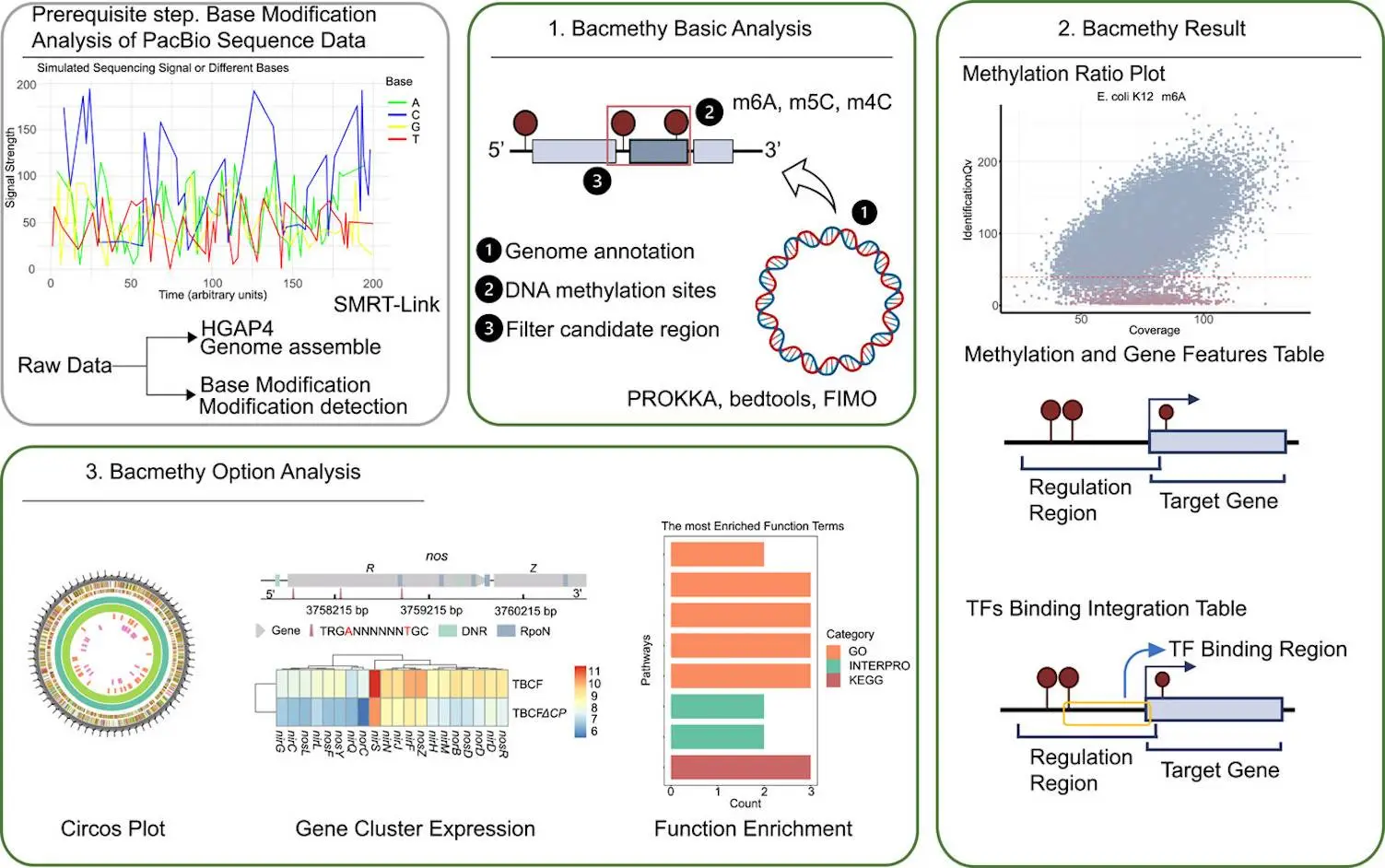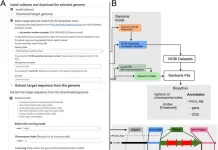DNA has been a holy grail as it is believed to contain all the intricate instructions that build and run an organism. However, scientists have recently found out that there is one more level of complexity called epigenetics, which affects gene expression without changing DNA sequence. In bacteria, DNA methylation serves as an important epigenetic mechanism acting like a biological dimmer switch, fine-tuning the activity of genes. Understanding how this methylation takes place can help “decode” bacterial behavior and even create new medicines.
Once upon a time, examining patterns of methylation on bacterial DNA was known to be laborious and complicated. Nonetheless, everything has changed with the advent of Bacmethy – a novel bioinformatics tool. Developed by a committed group of researchers at the Southern University of Science and Technology, scientists are now able to examine these patterns using unprecedented ease and efficiency just so they may explore their impact on gene regulation.
Why is Bacterial DNA Methylation Important?
Bacteria are known for adaptability and resourcefulness despite their seemingly simple structure. This often hinges on their ability to precisely control gene expression. By adding one methyl molecule onto certain parts of the genome, DNA methylation works as a key regulator that affects whether certain genes will be activated. This dynamic control allows bacteria to fine-tune their behavior in response to environmental changes, resist antibiotics, or even cause diseases.
For example, some bacteria can methylate the genes that are responsible for virulence factors, thereby silencing them and decreasing pathogenicity. Conversely, they may remove methyl groups to turn on genes involved in antibiotic resistance. Understanding this complex dance between DNA methylation and gene regulation in bacteria opens up numerous exciting avenues.
The power of Bacmethy: A user-friendly approach
Previously, analyzing bacterial DNA methylation patterns required complex workflows and specialized knowledge in this field. However, Bacmethy has challenged this assumption by creating an easy-to-use interface for researchers who have little to no bioinformatics background. This is why Bacmethy is a revolution:
- Tapping into SMRT-seq Might: Single-molecule real-time Sequencing (SMRT-seq) is the technological platform that Bacmethy relies on to determine methylation at the level of a single nucleotide. The result of this data is a high-resolution map of methyl groups across the entire bacterial genome.
- Decoding Methylation Landscape: After obtaining SMRT-seq data, Bacmethy carefully scrutinizes it to identify clusters of methylation sites around bacterial DNA. It monitors different levels of methylation within certain regions and describes motifs underlying such methylation. Such techniques enable us to spot genes that are likely to be influenced by methylation and should thus be prioritized for future studies.
- Not Just Basics: Bacmethy does not just stop at identifying where methylation patterns lie; instead, Bacmethy investigates the enrichment of methylation in promoter regulatory regions that initiate gene expression and may, therefore, predict how it affects gene activation or silencing.
The Benefits of Unveiling the Bacterial Methylation Code:
Bacmethy has great value to researchers in divergent disciplines of science. Some of them include:
- Understanding Bacterial Pathogenesis: By revealing how methylation regulates genes involved in virulence, Bacmethy can be used to create new strategies against bacterial infections.
- Antibiotic Resistance Unveiled: Investigating methylation patterns in antibiotic-resistant bacteria can reveal mechanisms employed to evade these drugs. This knowledge can pave the way for developing next-generation antibiotics that circumvent these resistance mechanisms.
- Unlocking Bacterial Physiology: Bacmethy can contribute to a deeper understanding of bacterial physiology and adaptation by comprehending how methylation influences gene expression in response to environmental changes.
- Biotechnological Applications: Insights gained from Bacmethy can be harnessed for various biotechnological applications. A case in point is when scientists manipulate bacterial methylation patterns to create strains with specific properties, such as improved biofuel production or valuable chemicals.
The Future of Bacmethy
It is this aspect of user-friendliness and the ability to carry out various kinds of analysis that have made it possible for scientists to explore the vast world of bacterial epigenetics within a very short time. Thus, in the next several years, many revelations will arise from sifting Bacmethy data. This new knowledge holds much promise and may change our perception of how bacteria behave. It will also provide insight into medicine, biotechnology, and other areas, leading to a better appreciation of microbes.
Discovering New Research Avenues with Bacmethy
The advent of Bacmethy challenges scientists. Therefore, any researcher interested in bacterial behavior, pathogenesis, or physiology should take advantage of this fantastic resource. The power behind us in unraveling bacteria DNA methylation maze lies in Bacmethy. There are different ways you can choose from:
- Join the Bacmethy Community: For example, there are detailed tools and tutorials provided by Bacmethy developers. Visit their website, participate in online forums, and meet other researchers. Sharing experiences and knowledge will lead us to further comprehension.
- Add your contribution to Knowledge Base: As more researchers venture into the Bacmethy business, there will be a lot of good information that can be generated. Perhaps your findings could be entered into online databases or co-authored manuscripts that would enhance the collective pool of knowledge on bacterial DNA methylation.
- Discovering New Worlds: Bacmethy opens up new doors for research. Do not be afraid to try something different! For example, explore how Methylation patterns correlate with particular behaviors in bacteria or learn about environmental factors affecting methylation dynamics. Just follow your path!
The Coming Era of Bacterial Epigenetics: A New Frontier Beckons Beyond Bacmethy
Bacmethy is just the tip of the iceberg in the amazing world of bacterial epigenetics. This is a sneak peek into what may lie ahead:
- Integration with Other Omics Data: To have a complete picture, researchers will need to combine results from Bacmethy and other omics technologies like transcriptomics (gene expression analysis) and proteomics (protein analysis).
- Development of New Bioinformatics Tools: As our understanding of bacterial epigenetics increases, new bioinformatics tools will emerge. These are capable of using artificial intelligence algorithms such as machine learning to identify more complex methylation patterns precisely and predict their regulatory function.
- Single-Cell Methylation Analysis: At present, Bacmethy carries out its analyses on groups of bacterial cells. There might be advancements in single-cell methylation analysis in the future, allowing us to observe the diversity within these populations, which would then help us understand how different bacteria use methylation for various purposes.
Conclusion: A New Era in Bacterial Research
Bacmethy’s advent is a defining point in bacterial research. This easy-to-use and forceful tool authorizes scientists to decode the complex code of bacterial methylation of DNA, opening up the secrets behind gene regulation as well as its effect on bacteria behavior. As Bacmethy gains acceptance among researchers, we are waiting for a flood of breakthroughs that will redefine scientific knowledge. These findings are expected to change how society understands bacteria; they will also provide the basis for future improvements in healthcare services, biological technology applications, and our overall understanding of microbial life. May this be an appeal to take part in a scientific journey through which we shall collectively decipher the puzzle pieces that build up bacterial epigenetics as a whole and then rewrite everything known about bacterial life at large?
Article source: Reference Paper | Bacmethy’s user-friendly web server interface is available on the website.
Follow Us!
Learn More:
Anchal is a consulting scientific writing intern at CBIRT with a passion for bioinformatics and its miracles. She is pursuing an MTech in Bioinformatics from Delhi Technological University, Delhi. Through engaging prose, she invites readers to explore the captivating world of bioinformatics, showcasing its groundbreaking contributions to understanding the mysteries of life. Besides science, she enjoys reading and painting.
















